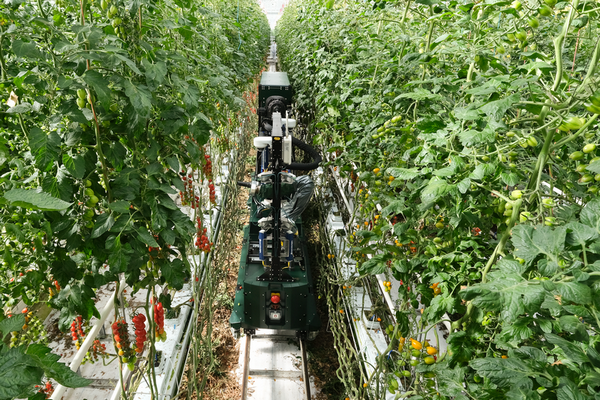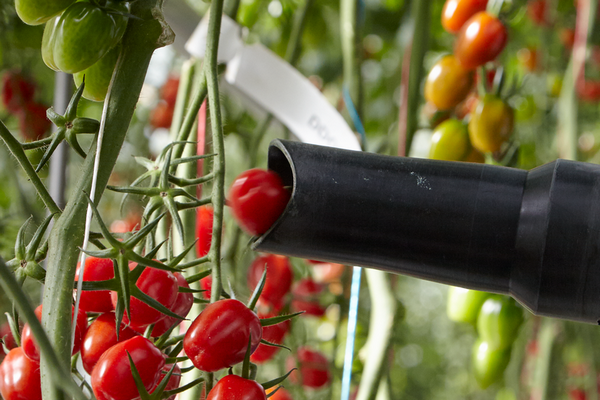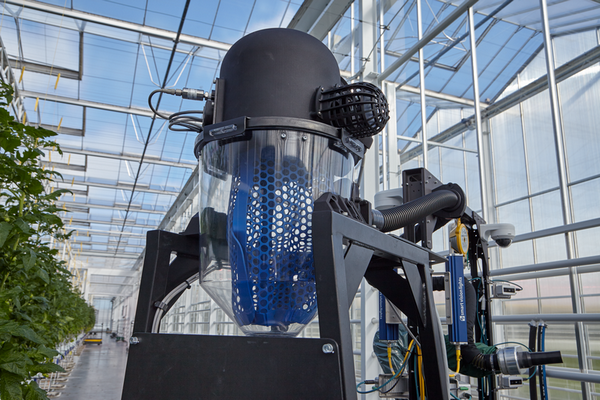The future of food production will require greater efficiencies, sustainable practices, and maximizing yields at every step. To optimize the future production of tomatoes, Syngenta Vegetable Seeds recently worked with Pittsburgh, Pa.-based Four Growers, Inc. to test the GR-100 robotic harvester in tomato research. "The robot sees the tomato, identifies its ripeness, decides whether or not to pick it. If it decides to pick it, it'll go up suck it in to the vacuum system, pass through the tube and drops it into a crate. Then the crate will get shifted into the packing cart", shows Zack Walker, field engineer with Four Growers.
"This collaboration helps serve as a link between genetics and automation," said Ruud Kaagman, Syngenta Global Crop Unit Head – Tomato. "The success of robotization in the future is the application of robotics with different plant characteristics. With this collaboration, you'll see varieties adapted to robotic harvesting to enable growers' success."
Robotics paired with genetics put technology and nature together to create a better future for this healthy crop eaten around the world. The work between Syngenta and Four Growers could lead to faster crop advancements, reduced food waste, and more satisfied growers and consumers.

Enable Labor Cost Reduction
Today tomatoes are harvested with human hands, which accounts for a sizeable portion of overall production costs – up to 30% of the total. On top of costs, growers are finding it more difficult to find enough laborers. With rampant labor shortages, growers need solutions to ensure consumers have access to the tomatoes they need.
Enter robotic harvesting
"Using robotics in agriculture will enable us to eat higher quality, healthier, more affordable produce," said Brandon Contino, Four Growers CEO. "Unlike other machines that we see in the field today that harvest every crop (ripe or unripe) in one pass, at Four Growers, our robotics and AI enable us to pick produce individually so that we only harvest those that are perfectly ripe."

Harvesting robots can save time and human resources. For Syngenta, it's important to partner with Four Growers to be ready for the production styles of the future and fully understand growers' needs.
Robotics in Tomato Research
To optimize the efficiency of harvesting robots, growers need a combination of an intuitive machine and plants designed to work with them. That's why Syngenta is including robotics in the research stage of development to pick plant structures that work best with machine harvesting.
"Syngenta is developing varieties for the future of our growers, so we need to understand how growers will be running their operations in five to 10 years from now," Kaagman said. "We will make sure that when growers move to robotization on a large scale, we have varieties for them that will help them gain efficiencies and added value from robotization."
Take fruit placement, for example, today's tomato clusters are positioned throughout the plant. Some hidden behind stems and leaves, some in tight clusters, and so on. These positions might make it difficult for a robotic harvester to identify and pick the crop. With this knowledge, Syngenta researchers can select the genetics that positions fruit clusters in an optimal way for all future tomato varieties.
"Working with Syngenta provides an opportunity for us to leverage each other's knowledge and strengths," Contino said. "By combining these architectures with the characteristics for delicious taste, we can help breed a more affordable, better-tasting tomato."

Machine Learning for Faster Innovation
For most tomato varieties on the market, it can take up to eight years of research and thousands of data points to make it to grower fields and greenhouses. Instead of relying on human data collection, robotics, and artificial intelligence means, researchers can collect more data points with a higher degree of accuracy than ever before.
"The better the data is, the better it is for us to select the right variety that we want to commercialize," Kaagman explained. "These robots have options that we can use beyond just harvesting the fruit – like cameras and weighing devices. So, it's counting the number of fruits, checking the size of the fruit, weighing the fruit, and calculating total yields. There's a lot of data points the robot collects now that we had to historically collect with human eyes."
Unlike human eyes, robots don't get tired or have bias, so the data is more accurate than ever before.
"From the 20+ imagers to the other sensors we have on the system, we can provide a level of data granularity and insights that growers (and researchers) have never had before; thereby allowing them to grow a better tomato," Contino said. "Our collaboration with Syngenta will enable growers to buy seed bred with the learning of robotics and AI internally, which right out of the gate gives them a head start in producing the best product at the best price for their consumer.
With more accurate data, Syngenta researchers can weed out the less desirable candidates faster and focus efforts on more promising tomato varieties. At the end of the day, it means new tomato innovations hit the market faster, with more data behind them.
For more information:
Syngenta Group
www.syngenta.com
Four Growers
www.FourGrowers.com 
